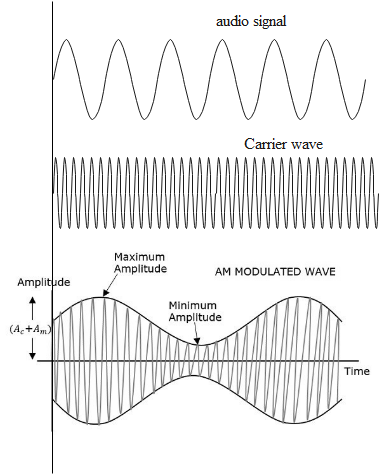
(a) Give three reasons why modulation of a message signal is necessary for long distance transmission.
(b) Show graphically an audio signal, a carrier wave and an amplitude modulated wave.
Answer
490.5k+ views
Hint: In communication, we need to send signals from one place to another over large distances. But a simple transverse wave signal can get a lot of distortions due to the obstacles in the path of the communication due to which need some ways to ensure efficient signal transmission from one place to another.
Complete step by step answer:
(a). In communication, we use electromagnetic waves which are transverse in nature. They are used to transmit a signal from a sending antenna to a receiving antenna.
The message signal cannot be sent directly in its original form from one place to another because that way the signal dies out very quickly and long distance communication is not possible.
Modulation allows a number of benefits for communication.
It allows us to transmit a signal over a range of frequencies called bandwidth of the channel.
The modulated signals do not interfere with each other.
Lower the frequency of a signal, larger is the antenna required to transmit that signal. But through modulation, we can send signals by modulating it to a higher frequency and be able to use a smaller antenna.
We have different ways in which we can modulate our message signal and then transmit it safely without excessive distortion from one place to another. These methods are amplitude modulation (AM), frequency modulation (FM) and phase modulation (PM).
(b). Following diagram represents an audio signal, a carrier wave and an amplitude modulated wave.

Note: A signal must not be modulated beyond a certain limit. This limit is defined by the modulation index which, for amplitude modulation, is equal to ratio of amplitude of the modulated wave to the amplitude of the carrier wave. Its value should not exceed one which can lead to over modulation.
Complete step by step answer:
(a). In communication, we use electromagnetic waves which are transverse in nature. They are used to transmit a signal from a sending antenna to a receiving antenna.
The message signal cannot be sent directly in its original form from one place to another because that way the signal dies out very quickly and long distance communication is not possible.
Modulation allows a number of benefits for communication.
It allows us to transmit a signal over a range of frequencies called bandwidth of the channel.
The modulated signals do not interfere with each other.
Lower the frequency of a signal, larger is the antenna required to transmit that signal. But through modulation, we can send signals by modulating it to a higher frequency and be able to use a smaller antenna.
We have different ways in which we can modulate our message signal and then transmit it safely without excessive distortion from one place to another. These methods are amplitude modulation (AM), frequency modulation (FM) and phase modulation (PM).
(b). Following diagram represents an audio signal, a carrier wave and an amplitude modulated wave.

Note: A signal must not be modulated beyond a certain limit. This limit is defined by the modulation index which, for amplitude modulation, is equal to ratio of amplitude of the modulated wave to the amplitude of the carrier wave. Its value should not exceed one which can lead to over modulation.
Recently Updated Pages
Master Class 11 Accountancy: Engaging Questions & Answers for Success

Express the following as a fraction and simplify a class 7 maths CBSE

The length and width of a rectangle are in ratio of class 7 maths CBSE

The ratio of the income to the expenditure of a family class 7 maths CBSE

How do you write 025 million in scientific notatio class 7 maths CBSE

How do you convert 295 meters per second to kilometers class 7 maths CBSE

Trending doubts
Which are the Top 10 Largest Countries of the World?

Differentiate between homogeneous and heterogeneous class 12 chemistry CBSE

What is a transformer Explain the principle construction class 12 physics CBSE

Draw a labelled sketch of the human eye class 12 physics CBSE

What is the Full Form of PVC, PET, HDPE, LDPE, PP and PS ?

How much time does it take to bleed after eating p class 12 biology CBSE




